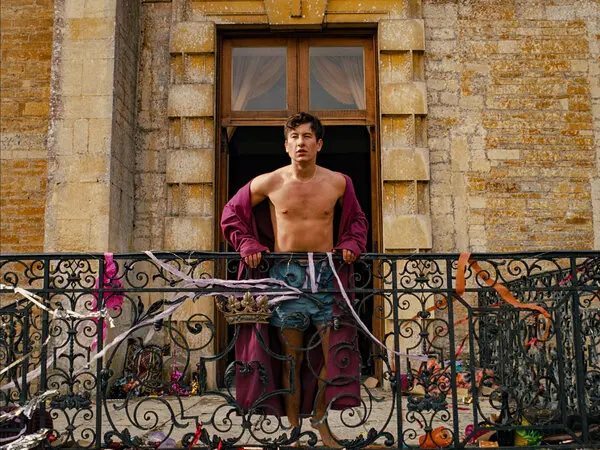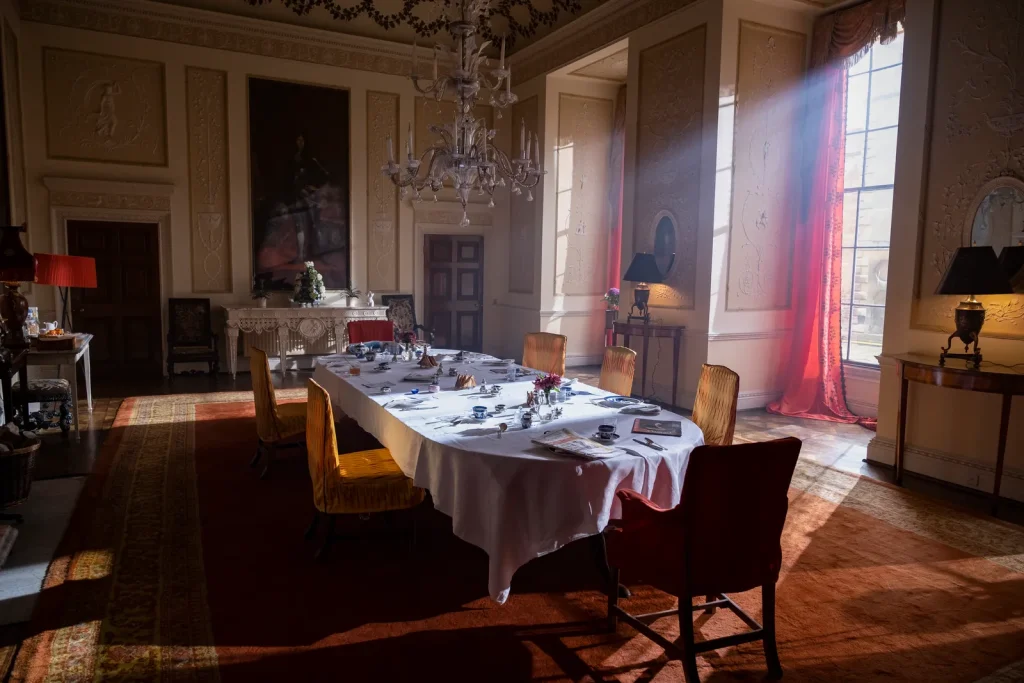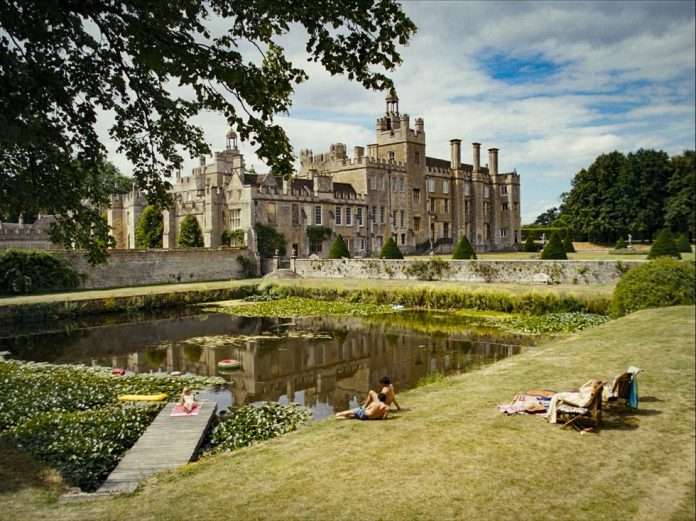The hypnotic thriller Saltburn is filled with unexpected twists and turns. So is the real-life carbon footprint of the estate backdrop for the Amazon/Warner Bros. thriller.
Warning: spoilers ahead.
Emerald Fennell’s revenge comedy Saltburn has the whole Internet talking. The jaw-dropping psychological thriller starring Academy Award nominee Barry Keoghan, along with Jacob Elordi, Carey Mulligan, Richard E. Grant, and Rosamund Pike, tells the story of a first-year Oxford University scholarship student, Oliver Quick (Keoghan), and his efforts to fit in with Felix Catton (Elordi). Catton invites Quick to spend the summer at his family’s Saltburn estate, which, in real life, is the 200-acre, 127-room Drayton House.
The Northamptonshire crenelated Baroque-style manse has belonged to the Stopford-Sackville family since the 1700s (the actual house was built around 1300). The estate features multiple pools, a lake, gardens, and the Shining-esque hedge maze built to serve up a critical plot point in the film.
Drayton House
“We managed to persuade the owners [of Drayton House],” production designer Suzie Davies told Architectural Digest. “Usually in National Trust and English Heritage properties you’re not allowed to paint anything or move pictures or augment or change anything. This family let us do quite a bit to the house and gave us free rein.”
Fennell told Architectural Digest that it’s typically not possible for one location to fit every need of a film. “That’s why the house was so important,” Fennell said. “And it needed to be something that hadn’t been used before. This hadn’t been photographed even, let alone put on film. We always wanted the exact sense that it is a real place.”
While Keoghan’s performance is undeniably brilliant, the estate is far more than just a befitting backdrop; it is a brooding, scene-stealing character all its own. (Spoiler: some plot theories put the estate behind the killings much like in Stanley Kubrick’s 1980 adaptation of Stephen King’s The Shining, starring Jack Nicholson and Shelley Duvall.)

Davies said the property helped deliver the “effortless style and the flamboyance” so central to the film.
“We needed it to feel desirable and almost out of reach,” she said. “But then there’s a slight disregard to everything that adds to the slight unease as the story gets more unhinged. We started off wanting the images to look like a Caravaggio painting, so that it is something that you’re envious of or you want. But then that painting starts to melt and distort as the story itself starts to distort.”
Beyond the perfect performance of Drayton House, we wanted to know about its real-life impact — specifically its climate impact.
There is no public information available about Drayton House emissions, but the environmental impact of large estates, such as those with dozens of rooms and sprawling over hundreds of acres, like Drayton House, is significant, particularly when they operate without the use of renewable energy sources.
Large buildings and estates play a crucial role in global energy consumption and emissions. Globally, building operations account for about 40 percent of carbon dioxide emissions per year, with approximately 70 percent of these emissions resulting from building operations, and the remaining 30 percent from construction. The operations of buildings alone contribute to 30 percent of global final energy consumption and 26 percent of global energy-related emissions.
Royal estates as examples
To understand the scale of energy consumption in large estates, examples like the Royal family’s Buckingham Palace are illustrative. Buckingham Palace, covering 828,821 square feet of land, incurs a staggering cost of £93,570 per month in energy bills, amounting to £1.12 million each year.

Another notable example, Blenheim Palace, a 1,450,000 square foot estate in Oxfordshire, costs approximately £163,687 to power each month, translating to nearly £2 million annually. Comparatively, Hampton Court Palace in South London costs about £5,357 per month, or nearly £65,000 every year.
According to the Center for Sustainable Systems at the University of Michigan, every kWh (kilowatt hour) of energy generated in the U.S. produces an average of 0.857 pounds of CO2e; coal releases 2.2 pounds, petroleum releases 2.0 pounds, and natural gas releases 0.9 pounds. In 2023, space heating and cooling accounted for an estimated 44 percent of energy (in U.S.) in residential buildings. Large estates are often not well insulated and drafty, requiring more energy to heat or cool.
Reducing emissions from large buildings and estates is a significant challenge. Efforts like those in New York, where legislation passed in 2019 sets emissions caps for buildings larger than 25,000 square feet, aim to reduce large buildings’ emissions by 40 percent by 2030 and 80 percent by 2050. Such measures demonstrate the potential for significant reductions in emissions through policy and technological interventions.
Like Keoghan’s Quick character spirals throughout Saltburn, the impact estates like Drayton House have on the environment isn’t immediately noticeable — but, undeniably, without a shift to renewable resources, they play a leading role in our real-world unraveling.
Related on Ethos:


